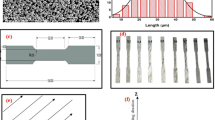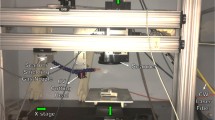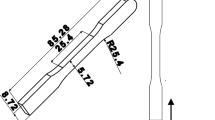Abstract
The 3D parts printed by the laser powder bed fusion (LPBF) process may have the disadvantages of residual stress, part deformation, and surface roughness. Post-processing is usually required to improve such part characteristics. This study investigated the effects of ultrasonic vibration-assisted compression (UAC) on stainless steel 316L parts fabricated by LPBF. The morphology of the molten pools, microstructure, and hardness by UAC and conventional compression (CC) were evaluated. It was found that UAC was more likely to refine the molten pools than CC. The number of sub-grain boundaries near the compressive surface was increased significantly by UAC. Compared with the CC sample, the UAC-processed specimens showed an increased hardness of 7%.







Similar content being viewed by others
References
Yadroitsev I, Gusarov A, Yadroitsava I, Smurov I (2010) Single track formation in selective laser melting of metal powders. J Mater Process Technol 210:1624–1631. https://doi.org/10.1016/j.jmatprotec.2010.05.010
Herzog D, Seyda V, Wycisk E, Emmelmann C (2016) Additive manufacturing of metals. Acta Mater 117:371–392. https://doi.org/10.1016/j.actamat.2016.07.019
Yin S, Chen C, Yan X, Feng X, Jenkins R, O ' Reilly P, Liu M, Li H, Lupoi R (2018) The influence of aging temperature and aging time on the mechanical and tribological properties of selective laser melted maraging 18Ni-300 steel. Additive Manufacturing 22:592–600. https://doi.org/10.1016/j.addma.2018.06.005
Kruth J-P, Deckers J, Yasa E, Wauthle R (2012) Assessing and comparing influencing factors of residual stresses in selective laser melting using a novel analysis method. Proc Inst Mech Eng B J Eng Manuf 226:980–991. https://doi.org/10.1177/0954405412437085
Grasso M, Colosimo B (2017) Process defects and In-situ monitoring methods in metal powder bed fusion: a review. Meas Sci Technol 28:1–25. https://doi.org/10.1088/1361-6501/aa5c4f
Spierings A, Starr T, Wegener K (2013) Fatigue performance of additive manufactured metallic parts. Rapid Prototyp J 19. https://doi.org/10.1108/13552541311302932
Liverani E, Lutey AHA, Ascari A, Fortunato A (2020) The effects of hot isostatic pressing (HIP) and solubilization heat treatment on the density, mechanical properties, and microstructure of austenitic stainless steel parts produced by selective laser melting (SLM). Int J Adv Manuf Technol 107(1):109–122. https://doi.org/10.1007/s00170-020-05072-9
Habibiyan A, Hanzaki AZ, Abedi HR (2020) An investigation into microstructure and high-temperature mechanical properties of selective laser-melted 316L stainless steel toward the development of hybrid Ampliforge process. Int J Adv Manuf Technol 110(1):383–394
Kalentics N, Sohrabi N, Ghasemi Tabasi H, Griffiths S, Jhabvala J, Leinenbach C, Burn A, Logé R (2019) Healing cracks in selective laser melting by 3D laser shock peening. Addit Manuf 30:100881. https://doi.org/10.1016/j.addma.2019.100881
Teramachi A, Yan J (2019) Improving the surface integrity of additive-manufactured metal parts by ultrasonic vibration-assisted burnishing. J Micro Nano-Manuf 7(2). https://doi.org/10.1115/1.4043344
Flores Ituarte I, Salmi M, Papula S, Huuki J, Hemming B, Coatanéa E, Nurmi S, Virkkunen I (2020) Surface modification of additively manufactured 18% Nickel Maraging steel by ultrasonic vibration-assisted ball burnishing. J Manuf Sci Eng:1–38. https://doi.org/10.1115/1.4046903
Zhang H, Chiang R, Qin H, Ren Z, Hou X, Lin D, Doll G, Vasudevan V, Dong Y, Ye C (2017) The effects of ultrasonic nanocrystal surface modification on the fatigue performance of 3D-printed Ti64. Int J Fatigue 103:136–146. https://doi.org/10.1016/j.ijfatigue.2017.05.019
Ma C, Taheri Andani M, Qin H, Shayesteh Moghaddam N, Ibrahim H, Jahadakbar A, Amerinatanzi A, Ren Z, Zhang H, Doll G, Dong Y, Elahinia M, Ye C (2017) Improving surface finish and wear resistance of additive manufactured nickel-titanium by ultrasonic nano-crystal surface modification. J Mater Process Technol:249. https://doi.org/10.1016/j.jmatprotec.2017.06.038
Maleki E, Bagherifard S, Bandini M, Guagliano M (2020) Surface post-treatments for metal additive manufacturing: progress, challenges, and opportunities. Additive Manufacturing:101619. https://doi.org/10.1016/j.addma.2020.101619
Liu Y, Suslov S, Han Q, Xu C, Hua L (2012) Microstructure of the pure copper produced by upsetting with ultrasonic vibration. Mater Lett 67:52–55. https://doi.org/10.1016/j.matlet.2011.08.086
Liu T, Lin J, Guan Y, Xie Z, Zhu L, Zhai J (2018) Effects of ultrasonic vibration on the compression of pure titanium. Ultrasonics 89:26–33. https://doi.org/10.1016/j.ultras.2018.04.006
Hung J-C, Tsai Y-C, Hung C-H (2007) Frictional effect of ultrasonic-vibration on upsetting. Ultrasonics 46(3):277–284
Qingmei L, Yong Z, Yaoling S, Feipeng Q, Qijie Z (2007) Influence of ultrasonic vibration on mechanical properties and microstructure of 1Cr18Ni9Ti stainless steel. Mater Des 28(6):1949–1952. https://doi.org/10.1016/j.matdes.2006.04.025
Liu X, Osawa Y, Takamori S, Mukai T (2008) Microstructure and mechanical properties of AZ91 alloy produced with ultrasonic vibration. Mater Sci Eng A 487:120–123. https://doi.org/10.1016/j.msea.2007.09.071
Availability of data and materials
Not applicable
Funding
This work was supported by the Ministry of Science and Technology of Republic of China, under Contract MOST 109-2221-E-009-029.
Author information
Authors and Affiliations
Contributions
Chung-Wei Cheng: Conceptualization, supervision, and writing-original draft preparation.
Teoh Boon How: Investigation, measurement, and data curation.
Yi-Hsien Liu: Investigation, measurement, and data curation.
Ching-Hua Hung: Conceptualization, supervision, and writing-original draft preparation.
Corresponding author
Ethics declarations
Ethics approval
Not applicable
Consent to participate
Not applicable
Consent for publish
Not applicable
Competing interests
The authors declare no competing interests.
Additional information
Publisher’s note
Springer Nature remains neutral with regard to jurisdictional claims in published maps and institutional affiliations.
Rights and permissions
About this article
Cite this article
Cheng, CW., How, T.B., Liu, YH. et al. Effects of ultrasonic vibration-assisted compression of stainless steel 316L produced by laser powder bed fusion. Int J Adv Manuf Technol 117, 159–165 (2021). https://doi.org/10.1007/s00170-021-07620-3
Received:
Accepted:
Published:
Issue Date:
DOI: https://doi.org/10.1007/s00170-021-07620-3




